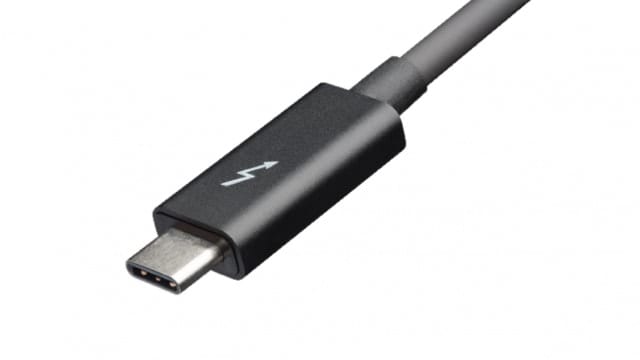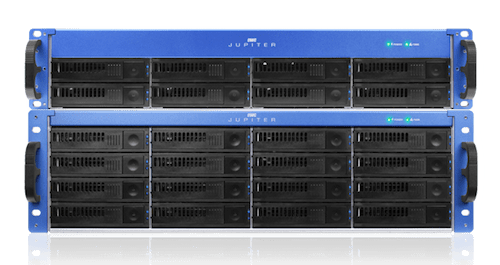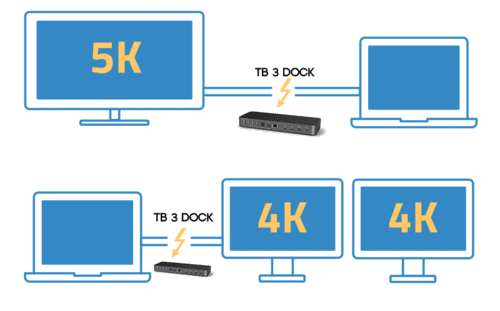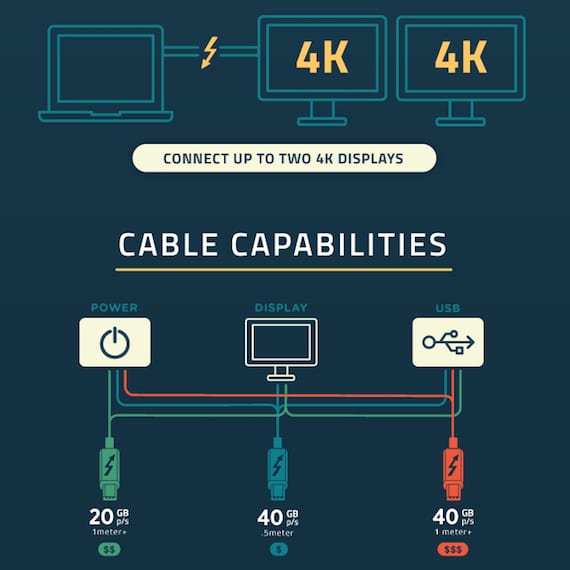
This is the second in a series of articles on the Rocket Yard discussing Thunderbolt 3 technology. Last week, the first article gave readers a rundown on the history of Thunderbolt, a hardware interface that was designed from the start to connect multiple external peripherals — like external disk drives and high-definition monitors — at very high data rates. This week’s post discusses just how fast and powerful Thunderbolt 3 is, backward compatibility issues with existing Thunderbolt 2 devices, the decision to use the USB Type-C connector for Thunderbolt 3, and how Thunderbolt 3 compares to current competing interface technologies.
Theoretical Speeds
With a maximum theoretical transfer rate of 40 Gigabits per second (5GB/second), Thunderbolt 3 is undoubtedly fast (we’ll share more on what is needed to actually reach the theoretical 40Gbps later in this article). That’s twice the speed of Thunderbolt 2, and four times the transfer rate of the original Thunderbolt specification. What this means for Mac and PC users is that writing data to an external drive for backups or storing large media files is much faster, as is the retrieval of data from those drives.
But external hard drives, RAID arrays, or solid-state drives aren’t the only devices that can be used with a Thunderbolt 3 connection. Since the job of connectivity technologies like Thunderbolt is to “move bits”, those bits can be displayed on a monitor just as easily as they can be stored on media. The original Thunderbolt specification was good enough to drive Apple’s discontinued Thunderbolt Display, which displayed 2,560 X 1,440 pixels on a 27-inch diagonal display (a 16:9 aspect ratio).
Thunderbolt 2 made it possible for a Mac or PC to drive a 4K (UHD-1) display with a resolution of 3,840 X 2,160 pixels, once again at a 16:9 aspect ratio. Even more importantly, Thunderbolt 2 can simultaneously deliver that 4K (2160p) video stream to a display and to storage.
Both the original Thunderbolt and Thunderbolt 2 pale by comparison to Thunderbolt 3 in terms of speed. The new hardware provides enough speed to deliver video to two 4K displays at a 60 frame per second refresh rate or to a single 4K display at 120 frames per second.
Compatibility Caveat
One of the big questions facing many Mac and PC owners is whether their existing Thunderbolt devices — whether it’s displays, drives, or docks — will work with future computers equipped with Thunderbolt 3 ports. That’s a good question since Thunderbolt 3 does away with the Mini DisplayPort connectors used for Thunderbolt and Thunderbolt 2, replacing them with USB Type-C (AKA USB-C) connectors.
Unfortunately, it’s a good question without a good answer – at least for many users and future Thunderbolt 3 adopters. Because Thunderbolt 3 uses the USB Type-C connector, users will need an adapter to allow the connection of original Thunderbolt/Thunderbolt 2 peripherals to Thunderbolt 3-equipped computers, which is an added expense and inconvenience that many might not be happy with. It also should be added that Thunderbolt 3 devices will likely never be compatible with a Thunderbolt 2 host.

Daisy Chains
Another feature of Thunderbolt has been the ability to daisy-chain devices; in other words, connecting a computer to a first device with two Thunderbolt ports, then connecting that to a second device with two ports, and so on. With Apple’s initial Thunderbolt devices, up to six devices could be connected to a single Thunderbolt port, with a DisplayPort monitor like the Thunderbolt Display at the end of the daisy chain.
Thunderbolt 3 continues the tradition of daisy-chaining devices. By using the USB Type-C connector standard, Thunderbolt 3 ports can provide up to 15 Watts of power to the daisy-chained devices.
USB Type-C, Thunderbolt 3 & Potential Confusion
In previous paragraphs, I’ve referred to the fact that Thunderbolt 3 uses the USB Type-C connector. If you’ve had the opportunity to look at or work with an Apple 12-inch Retina Display MacBook — the only Mac equipped with USB-C at this time — you’ve seen a tiny port and connector that is bi-directional. In other words, unlike the traditional USB connector or the Mini DisplayPort connector used with Thunderbolt and Thunderbolt 2, there’s no “wrong way” to plug in the connector, no up or down. Take it from a person who almost always tries to plug USB devices upside-down the first time, USB-C’s form factor is refreshing.
Moving Thunderbolt 3 to the Type-C connector allows for a smaller connector, meaning that less volume is consumed in computers for the interface. Thunderbolt 3 and USB 3.1 Gen 2 support will be provided by the computer’s Thunderbolt chipset, and one (or more) port will be able to support both USB 3.1 Gen 2 and Thunderbolt 3 devices. How will you know if a port supports just USB or Thunderbolt 3 and USB? You’ll have to look for the little “Lightning Bolt” icon that graces the Thunderbolt port.
Any USB-C device that is plugged into a Thunderbolt 3 port will work, but at the slower USB-C speeds. So what about a Thunderbolt 3 device plugged into a USB-C-only port? If that device is something like a power adapter, it will probably work, but transferring data won’t happen. Expect some confusion for a while as USB-C becomes ubiquitous on more devices and Thunderbolt 3 support is added later.
Cable Capabilities
Although Thunderbolt 3 cable prices are likely to be lower than those for the two original Thunderbolt implementations, there is a catch – there will be both passive and active cables available. And all cables are not created equally in build and in price…
A passive Thunderbolt 3 cable at 0.5M length can push data at 40 Gbps however 1M an 2M can only hit 20 Gbps; the same speed as Thunderbolt 2 and twice the speed of USB. You’ll be able to use passive Thunderbolt 3 cables as USB-C however a USB-C cable cannot be used as a Thunderbolt 3 cable. But to get the raw speed out of Thunderbolt 3 at 40 Gbps at 1M or longer, you’ll need what’s called an active Thunderbolt 3 cable.
What’s the difference? The active cables have chips built into them to allow the highest possible data transfer speeds. Active cables are a must if you’ll be connecting your workstation to an SSD-based RAID array for raw storage speed. Those cables will be no more than six feet (2 meters) in length. For further distance requirements, some Thunderbolt 3 active cables may use fiber optics rather than copper to push the signal up to 200 feet away.
Adapters
So, your future 2017 MacBook Pro has a bunch of Thunderbolt 3-capable USB Type-C ports on it, but nothing else — kind of like a 12-inch MacBook on steroids. You’ll likely be in the market for adapters. USB-C adapters for HDMI, VGA projectors, Ethernet, and so on that you can buy today should work just fine when plugged into that Thunderbolt 3 port provided they use the correct type of cable and/or adapters. Of course, we will keep you informed about the compatibility of specific devices or features as more Thunderbolt 3 host products come to the market.
Spec Wars
What other technologies are currently competing with Thunderbolt 3? Let’s take a look at what’s available:
FireWire – Although FireWire S1600 and S3200 standards were developed, with the latter allowing data transfer speeds up to 3.4157 Gbps, almost no devices were actually manufactured for sale. The one exception was a Sony camera sold in 2012 that supported FireWire S1600.
eSATA – eSATA is an implementation of the Serial ATA data bus that’s meant for use with external drives. The most current version of eSATA is eSATA 6G, which tops out at 6 Gbps. MacSales.com offers an ExpressCard/34 eSATA adapter for the older (2006-2011) MacBook Pro, and eSATA PCI-Express cards for the older (2006-mid 2012) Mac Pro, but there’s nothing for the newer Macs. It appears that eSATA has been bypassed by faster and more capable interface options.
USB 3.1 gen 2 – I don’t really see USB 3.1 gen 2 as competing with Thunderbolt 3 — instead, they coexist, able to use the same port. (For much more on USB 3.1, read our History of USB article here.)

SAS/Mini SAS – Back in the dark ages of computing (1980s – 1990s) there was a common way to connect computers and peripherals called SCSI (Small Computer System Interface). I won’t go into its qualms, but let’s just say that it’s good things moved on. SCSI has evolved into SAS — Serial-Attached SCSI — and it’s a fast way to connect computers to mass amounts of storage. Mini SAS connectors and cables can be doubled up to produce data transfer speeds of up to 48 Gbps, as seen in the OWC Jupiter Kore Mini SAS Connected JBOD Storage System. The only issue? Finding a computer that can use a Mini SAS adapter card. An older Mac Pro (pre-late 2013) will work, but unfortunately, no modern Macs have the internal PCI-e ports that those adapters can plug into.
10 Gbps Ethernet – Ethernet has been around since the 1980s as a wired network protocol, and it works great for sharing mass storage as well. Creative professionals and others who need access to hundreds of terabytes of storage use network-attached storage (NAS) and storage area networks (SAN). 10 GBps Ethernet is used to connect single or multiple devices to storage devices like OWC Jupiter Callisto Ethernet Connected Shared Storage. The Mac Pro hasn’t yet caught up to 10 Gbps Ethernet, featuring a pair of 1 Gbps Ethernet ports. Fortunately, devices like the Jupiter Callisto are operable at the slower Gigabit Ethernet speeds.
Related article: Commentary: Apple Should Renew Focus on Mac Users, Pros.










Do you think it will be possible on the TB3 MacBook Pros to use an external graphics card in a TB3 enclosure like some PC makers do?
Curious the paragraph on eSata above. eSata consistently outperforms USB 3 according to Benchmarks on OWC/Macsales. There are eSata cards for Mac Pro towers and Thunderbolt to eSata adapters. I have one of each. It seems that eSata could live for some time still. It is plenty fast enough for spinning Hard Drives or even a Raid 0 HDD set. These can be had for a much reduced cost over switching bulk storage over to Thunderbolt.
On the new mbp15″ range. Is it two ports per TB3 bus? Similar to the Mac Pro with 6 tv ports?
Will Having two capable storage devices connected with the active cable on same bus both achieve their top theoretical speeds or is it half that, spread over the two ports on same bus?
Nice post but left a little disappointed as I was expecting something detailing how bandwidth is divided up in a dock for example and how the 3 different versions handle it and what effect connecting and using various devices has on the bandwidth for other ports on docks and other daisy-chained devices. More technical explanation about the idea of multiple 10Gbps pipes being aggregated for T2 and is this simply doubled for T3? Using DisplayPort alternate mode on USB-C vs. Thunderbolt Display adapters and how they affect bandwidth and cpu usage etc.
This is also what I was looking for. I want to know, for example, would the speed of a Thunderbolt 3 SSD (eg Samsung x5) be limited to usb 3 speeds if I plug USB devices into my Thundrbolt 3 hub.
The OWC Thunderbolt 3 Hub (OWCTB4HUB5P) has three T3 controllers. As such, devices connected to each of the three do not change the functionality of the respective other ports. However, bandwidth to an from the host device (the computer) is still shared at a maximum of 40Gbps total. So, you won’t get three 40Gbps streams. You will get a single 40Gbps stream spread across three ports.
“The new hardware provides enough speed to deliver video to two 4K displays at a 60 frame per second refresh rate or to a single 4K display at 120 frames per second.”
What about 5K?
Thanks for asking! I did a search and found this from Intel on “thunderbolttechnology.net”:
“Thunderbolt 3 is based on the DisplayPort 1.2 specification and can support up to 2 streams (eight lanes) of DisplayPort 1.2 video bandwidth. A single cable now provides four times the data and twice the video bandwidth of any other cable, while also supplying up to 100W of power.
One 4K display (4096 x 2160) 30-bit @ 120 Hz
One 5K display (5120 x 2880) 30-bit @ 60 Hz
Two 4K displays each (4096 x 2160) 30-bit @ 60 Hz
– See more at: https://thunderbolttechnology.net/tech/faq#sthash.icppIcmU.dpuf
So 5K is absolutely in the cards for T3. However, 8K will require even more speed (Thunderbolt 4??), about 80Gbps (10GBps).
Steve